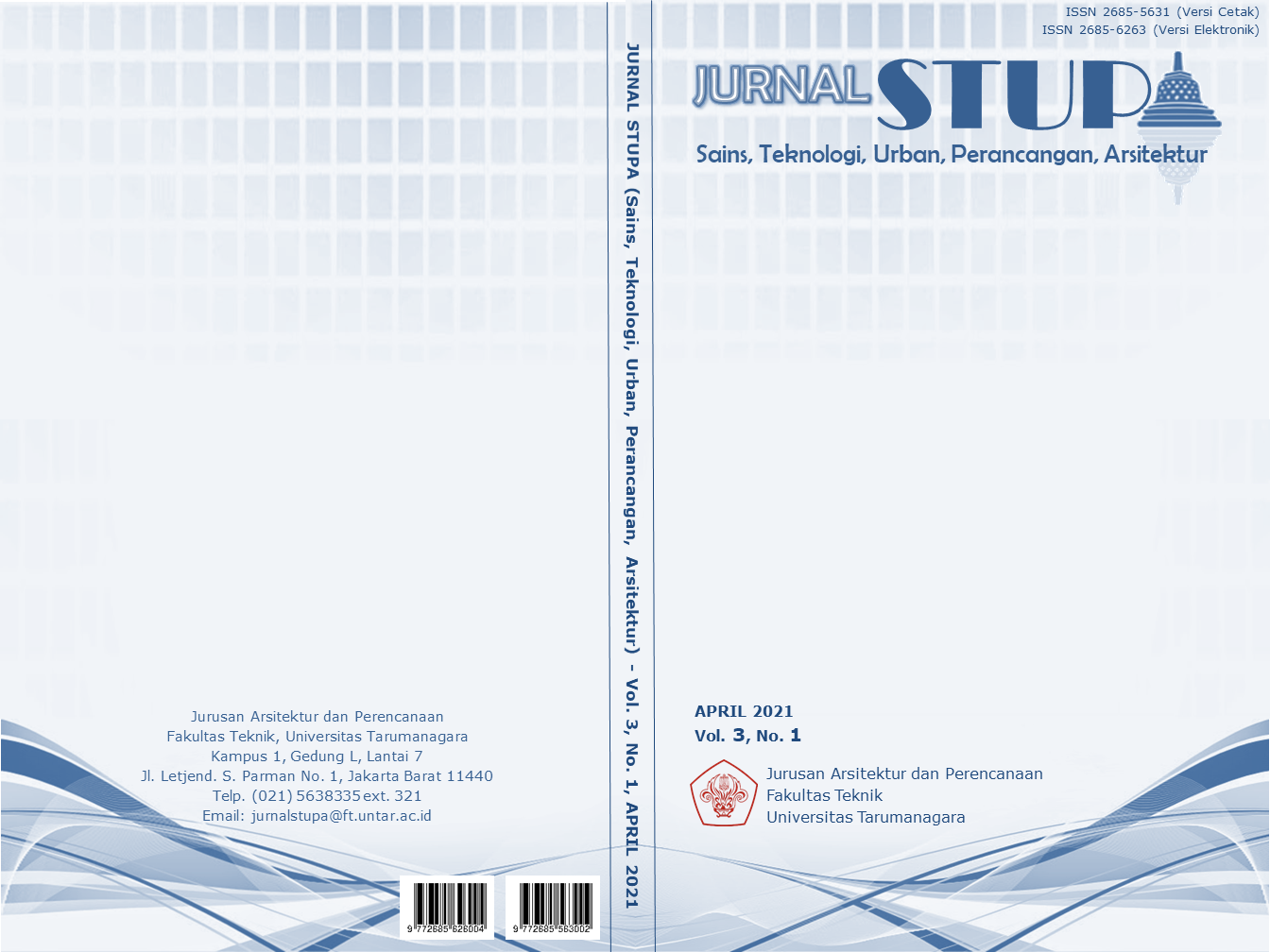RUANG KERJA DAN RELAKSASI BIOFILIK MASA DEPAN DI TUGU UTARA
Main Article Content
Abstract
In dwelling, humans will always adapt to all changes that occur to stay alive and exist. With the COVID-19 pandemic, there have been many changes, one of which is in the way we work. Responding from WFH (Work From Home) to the COVID-19 Pandemic and Future Work Trends (remote working) which cause various problems (anxiety, loss of restroom, etc.) and the need to work, there is a need for projects that can accommodate Work Near Home, Relaxation, Social Interaction, and Connection to Nature. The Project consists of two programs, namely active and passive leisure programs, and co-working. The project also responds primarily to the millennial generation and Gen Z workers. Where it is hoped that these two programs can maintain a work-life balance and balance between the realm, natural, and digital world. For the applied design concept, the project has a cluster typology. Each cluster consists of several masses, varied programs, and each space becomes its mass. The Biophilic concept is also applied to design. The first aspect is Visual & Non-visual Connection to Nature, by presenting vegetation elements around the site and around the mass of the building, which aims to create a new work experience and relaxation. The second aspect is Biomorphic Form & Pattern, where the patterns formed are representations of living things. The building masses is inspired by the leaves of the lotus plant which influence the shape, size, and placement of the masses. The water element is added to create a floating impression like a lotus. So that with the creation of this project, it can fulfill dwelling in work and relaxation.
Keywords: Bio-Philic; Cluster; COVID-19; Work Near Home
Abstrak
Dalam ber-dwelling, manusia akan selalu beradaptasi terhadap segala perubahan yang terjadi agar dapat tetap hidup dan ada (exist). Dengan adanya Pandemi COVID-19, menciptakan banyak perubahan, salah satunya terhadap cara kita bekerja. Merespon dari WFH (Work From Home) akan Pandemi COVID-19 dan Trend Bekerja Masa Depan (remote working) yang menimbulkan berbagai masalah (anxiety, kehilangan ruang istirahat, dll) dan kebutuhan akan bekerja, maka muncul kebutuhan akan proyek yang dapat mewadahi Work Near Home Relaksasi, Interaksi Sosial serta Koneksi Ke Alam. Proyek ini terdiri atas dua program yaitu program Leisure aktif dan pasif serta Co-working. Proyek pun merespon terutama terhadap pekerja generasi milenial dan gen Z. Kedua program tersebut diharapkan dapat menjaga keseimbangan work life balance serta keseimbangan antara dunia realita, alam dan digital. Untuk konsep desain yang diterapkan, proyek memiliki tipologi kluster. Setiap kluster terdiri atas beberapa massa, program yang bervariasi dan setiap ruang menjadi massa sendiri. Konsep Biofilik juga diterapkan pada rancangan. Aspek pertama adalah Visual & Non visual Connection to Nature, dengan menghadirkan elemen vegetasi pada sekeliling tapak dan sekitar massa bangunan, yang bertujuan menciptakan pengalaman kerja dan relaksasi baru. Aspek kedua adalah Biomorphic Form & Pattern, melalui pola-pola yang terbentuk sebagai representasi dari makhluk hidup. Massa Bangunan terinspirasi dari daun tanaman teratai yang mempengaruhi bentuk, ukuran dan peletakan massa. Elemen air pun ditambahkan untuk menciptakan kesan mengambang layaknya teratai. Sehingga dengan terciptanya proyek ini, dapat memenuhi dwelling dalam bekerja dan relaksasi.
Article Details
References
Beyer, B. (2020, Agustus 20). Homeworking 2.0: new community at neighborhood level. Retrieved from www.dearchitect.nl: https://www.dearchitect.nl/stedenbouw/blog/2020/04/blog-thuiswerken-2-0-nieuwe-collectiviteit-op-buurtniveau-101241210?_ga=2.128472591.2054083985.1610963526-332174837.1610963526
Bobeck, A. (2020, September 1). Building Dwelling Thinking by Martin Heidegger (Translation and Commentary by Adam Bobeck). Retrieved from https://www.academia.edu/: https://www.academia.edu/34279818/Building_Dwelling_Thinking_by_Martin_Heidegger_Translation_and_Commentary_by_Adam_Bobeck_
Browning, W. D. (2014). 14 Patterns of Biophilic Design. New York: Terrapin Bright Green, LLC.
Gilchrist, K. (2019, 35). Make it. Retrieved 12 2, 2020, from How millennials and Gen Z are reshaping the future of the workforce: https://www.cnbc.com/2019/03/05/how-millennials-and-gen-z-are-reshaping-the-future-of-the-workforce.html
Gold, S. M. (1980). Recreation, Planning, and Design. New York: Mc Graw Hill Book Company.
Noberg-Shulz, C. (1985). The Concept of Dwelling. New York: Rizzoli International Publications.
Pryke, N. (2020, Agustus 24). Gen Z: A New Generation of Workspaces. Retrieved from www.oktra.co.uk: https://www.oktra.co.uk/insights/gen-z-a-new-generation-of-workspaces/
Putra, D. I. (2020). Pedoman Umum Menghadapi Pandemi COVID 19 Bagi Pemerintah Daerah. Jakarta: Kementerian Dalam Negeri RI.
Shin, K. Y. (2013). Leisure Type, Leisure Satisfaction and Adolescents’ Psychological Wellbeing. Journal of Pacific Rim Psychology, 53-62. doi:10.1017/prp.2013.6
Verlinden, N. (2020, Agustus 23). Millennials vs. Gen Z: How Do They Achieve Success In The Workplace? . Retrieved from www.digitalhrtech.com: https://www.digitalhrtech.com/millennials-vs-gen-z/



